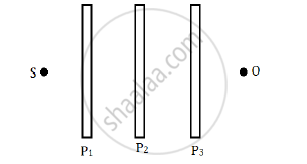Advertisements
Advertisements
प्रश्न
How is polarisation of light obtained by scattering of light?
उत्तर
- The light from a clear blue portion of the sky shows a rise and fall of intensity when viewed through a polaroid that is rotated.
- This is because of sunlight, which has changed its I direction (having been scattered) on encountering the molecules of the earth’s atmosphere.
- The electric field of light interacts with the electrons present in the air molecules.
- Under the influence of the electric field of the incident wave the electrons in the molecules acquire components of motion in both these directions.
- We have an observer looking at 90° to the direction of the sun. Clearly, charges accelerating parallel do not radiate energy towards this observer since their acceleration has no transverse component.
- The radiation scattered by the molecule is therefore polarized perpendicular to the plane.

Polarisation by scattering
APPEARS IN
संबंधित प्रश्न
Three identical polaroid sheets P1, P2 and P3 are oriented so that the pass axis of P2 and P3 are inclined at angles of 60° and 90° respectively with the pass axis of P1. A monochromatic source S of unpolarised light of intensity I0 is kept in front of the polaroid sheet P1 as shown in the figure. Determine the intensities of light as observed by the observer at O, when polaroid P3 is rotated with respect to P2 at angles θ = 30° and 60°.

What dose a polaroid consist of?
Show, using a simple polaroid, that light waves are transverse in nature. Intensity of light coming out of a polaroid does not change irrespective of the orientation of the pass axis of the polaroid. Explain why.
Why does an unpolarised light incident on a polaroid get linearly polarised ?
Find an expression for intensity of transmitted light when a polaroid sheet is rotated between two crossed polaroids. In which position of the polaroid sheet will the transmitted intensity be maximum?
Show, via a suitable diagram, how unpolarised light can be polarised by reflection.
The refractive indices of glass and water w.r.t. air are 3/2 and 4/3 respectively. Determine the refractive index of glass w.r.t. water.
Unpolarised light is passed through a polaroid P1. When this polarised beam passes through another polaroid P2 and if the pass axis of P2 makes angle θ with the pass axis of P1, then write the expression for the polarised beam passing through P2. Draw a plot showing the variation of intensity when θ varies from 0 to 2π.
State two uses of Polaroid.
Green light is incident at the polarising angle on a certain transparent medium. The angle of refraction is 30° . Find
(i) polarising angle, and
(ii) refractive index of the medium.
What is the difference between polarised light and unpolarised light?
Greenlight is an incident at the polarising angle on a certain transparent medium. The angle of refraction is 30°.
Find
(i) polarising angle, and
(ii) refractive index of the medium.
The transverse nature of light is shown in ______.
What is a analyser?
What is partially polarised light?
Mention the types of optically active crystals with example.
Can reflection result in plane polarised light if the light is incident on the interface from the side with higher refractive index?
A polarizer - analyser set is adjusted such that the intensity of light coming out of the analyser is just 10% of the original intensity. Assuming that the polarizer - analyser set does not absorb any light, the angle by which the analyser need to be rotated further to reduce the output intensity to be zero, is ______.
